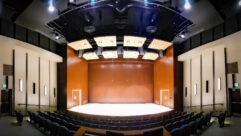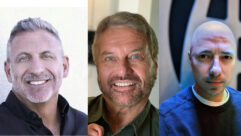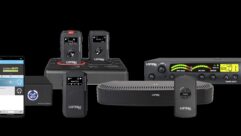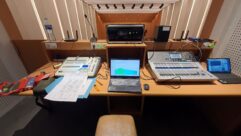A New Sound
Apr 1, 1998 12:00 PM,
Sam Gidren
Plagued by substandard sound quality for several years, things havegradually changed for the better at the Hollywood Bowl. Over the past threeyears, Hollywood Bowl sound designer Joseph Magee has led a total soundsystem renovation effort that has produced noticeable improvement. Workingwith Sound Image of Escondido, CA, the house reinforcement system has beenreplaced and upgraded, with work still continuing.
Constructed in 1922, the Hollywood Bowl was originally intended to hostclassical and symphonic musical performances, and it has served as thesummer home of the Los Angeles Philharmonic since it opened. The 18,000capacity outdoor venue offers very good natural acoustics, which were evenbetter prior to the arrival of the adjacent Hollywood Freeway in 1954. Now,a wide range of musical acts grace the Hollywood Bowl stage throughout theperformance season, and their diversity added to the sound design challenge.
“The whole point is that one system needs to work for everyone,” saidMagee. “It’s impossible to load systems in and out of here efficiently. Weneeded a system flexible enough to handle rock, jazz, orchestra, showtunes-you name it. So this has been among the primary design criteria.”
Long-term renovationThe new sound system is part of an overall renovation effort, with a widerange of facets updated. This effort will hopefully continue with theproposed new front-of-house mix position, a new acoustic shell and aproduction-oriented stage house, projected for completion by the year 2000.
The first two years of the sound system renovation effort were a bit tough.Major improvements were being made, but they weren’t really noticeable tothe audience. The third year, however, has marked a major breakthrough,with even the Los Angeles Times’ taking note in the form of a highlypositive sound profile during the summer 1997 season.
The first year a new console was installed, an 80-channel ATI Paragonmixing console with flying fader automation and new digital signalprocessing devices in the main system drive rack. A particular problemstemmed from other existing distributed loudspeakers and delay towers thatcould not be controlled adequately via the console’s matrix section.
The following year, new main loudspeaker arrays were added, consisting ofSound Image four-way loudspeakers in a left-center-right configuration.They have been flown-approximately 60 feet (18.3 m) above the stage-fromtemporary scaffold structures until the new shell is constructed.
QSC EX series amps replaced all of the former ones, delivering more than140,000 W and located at several positions throughout the venue. The ampracks dedicated to the main loudspeaker arrays, for example, are positionedimmediately beneath the cabinets in the scaffolding, keeping cable runsshort. A total of 106 EX amps power the system.
Also during year two, a critical addition was enacted in the form of aLevel Control Systems (LCS) digital mixing system. Three LCS LD-88 digitalmixers, controlled by LCS CuesControl software, combined to form a 16x20matrix, thereby allowing routing flexibility. Each LD-88 includes eightchannels of 20-bit input/output, along with eight digital signal processors(DSP) and a master DSP.
This matrixing capability has been expanded this year with the addition ofanother LD-88; the system now supports 32×32. Outputs are individuallyassigned to the loudspeaker subsystems. Any of 32 mixes generated by theParagon console and a Yamaha 03D digital console (also added this year) canbe distributed with precision to any of the 32 outputs feeding theloudspeakers.
“We mix classical orchestras, pop orchestras, solo recitals and jazzensembles back-to-back every day with little turnaround time. The LCSenables us to store different sub-mix cues for just about every instrumentcategory imaginable,” Magee explained. “We also have system control cuessaved in similar musical categories, or projects. Each morning, prior torehearsal, we recall a project that fits the artist’s needs, and we are upand running. The consistency of our mixes and system control has taken agreat leap forward by using this latest LCS system”.
Mics and pre-ampsA wide assortment of premium mics is available, ideal for meeting the needsof orchestral performances. Magee’s recording pedigree, particularly withthe classical focus, leads to use of Sennheiser and Neumann mics that arethe bedrock of that genre of the recording process. After all, the goal isto reproduce what happens in the studio.
“We use three Neumann TLM 50s as the main house mics on stage,” addedMagee. “They are positioned on the mic tree in a left-center-rightconfiguration for full coverage. We also use the Neumann KMS15Os on vocalswhenever we can. The vocal clarity on those mics is exceptional.”
“Sennheiser’s MKH8O are often ideal because they are so versatile. But,unlike the main L-C-R tree Neumanns, which remain consistent for allorchestral performances, the outriggers are subject to change depending onthe program,” said Magee.
This concept extends to the mic pre-amps, with 40 channels of Millenniaavailable along with ten channels of Avalon Class A and some tube-stagepre-amps as well.
“We vary color combination of the mics and pre-amps, just like you would inthe studio, to come up with the sound that the show dictates,” Magee noted.”This season we have purchased new Millennia tube-mic pre-amps, as well as24 channels of Grace pre-amps”.
The pre-amps feed the ATI and Yamaha consoles, with routing then done viathe LCS digital mixer/matrixing system. At this point, EQ and delay areincorporated as part of the general system calibration. The BSS Omnidrivesused in this role are outfitted with temperature and humidity probes,helping to adjust to optimum settings despite weather conditions that candramatically change at the venue.
The main systemThis year, the loudspeaker system was completed-no small task, with adistributed system along the promenade of the bowl made up of 122 SoundImage 500 Series carbon fiber nearfield loudspeakers concealed by hedges.In addition, loudspeakers are arranged in main, deck, front-fill and delaysubsystems, with all of these divided into 32 zones fed by the LCS.
The main loudspeaker system is comprised of 22 Sound Image (SI) Series V/WGfour-way loudspeakers, each with dual 15 inch (381 mm) woofers, dual 12inch (305 mm) woofers, dual mid/high waveguides coupled with 1.5 inch (38mm) exit compression drivers and four compression tweeters. All of thesecomponents, with the exception of the proprietary Sound Image waveguides,are JBL. The top of each array includes four SI series LT High Packs,loudspeakers that were custom designed for this project to boost mid- andhigh-frequency output to the farthest listening areas.
These loudspeakers, as mentioned, are configured in three physicalarrays-main left, main center and main right. The stereo capability in thecenter array assures a stereo image for the audience throughout the centerseating of the venue. Sub-low frequencies are supplied by ten Sound ImageSeries V subwoofers with four 18 inch (457 mm) JBL woofers flown at thebottom of each array.The deck system covers the front of the audience area. It is composed oftwo Series V/WG loudspeakers stacked atop of two Series V subwoofers, witheach located under the left and right arrays.
“The deck system enabled us to solve the problem of inferior sonicreproduction at the front, which had been an ongoing concern,” explainsRobert Mailman of Sound Image. “It has been working so well that we plan onadding to the system for even more comprehensive coverage during the 1998season.”
Three delay zones, timed with respect to the front arrays, cover extendedaudience areas. Each of these towers is retrofitted with a pair of SoundImage G5 Series carbon fiber enclosures consisting of a full-rangeloudspeaker and subwoofer. Six shadowed areas receive further coverage fromtwo Sound Image model 1250A carbon fiber loudspeakers. Additionalreinforcement is supplied by the distributed-hedge system-122 Sound Imagemodel 550 carbon fiber compact loudspeakers.
The right combinationAt the outset of the project, Magee spent a considerable amount of timebecoming familiar with the acoustic anomalies of the Hollywood Bowl, withthe system design reflecting attention to these details. Although it hasenough horsepower to make virtually any pop rock act happy, the primarygoal can best be summed up as the right combination of flexibility to offerhigh fidelity to enhance the performance of any act.
The long-running upgrade process is making an impact. Mark Swed of the LosAngeles Times reported after a tour of the new system that “the soundsystem produces a remarkably true and clearreproduction, even way up there(in the rear seating area).”
The LCS SuperNova System uses tightly integrated software and hardware toprovide the user with flexible and intuitive audio control. The basicbuilding block of the SuperNova system is the LD-88, a self-containeddigital audio processor with eight inputs and eight outputs. Up to 16LD-88s can be connected using the built-in 128-channel Novabus network,giving a maximum matrix size of 128 inputs and 128 outputs.
Signals can be dynamically routed from any combination of inputs to anycombination of outputs, and audio outputs may be treated either as matrixoutputs or auxiliary sends. Six parametric EQs and a delay up to 465 ms areprovided for each output. Five parametric EQs and a delay up to 160 ms areprovided for each input.
The SuperNova system’s mix configuration is specified in Cuestationsoftware by the user and is limited only by the number of physical inputsand outputs. For example, a system of four LD-88s yields a 32 x 32 matrix,which can be variously configured to have 32 inputs x 24 buses x 32outputs, 32 x 16 x 20 with 12 auxiliary sends or 32 x 40 x 30 with twoauxiliary sends.
Cuestation stores its presets in cues, which can contain all or a subset ofthe automation information for the entire system. In addition, cues cancontain control information that may be transmitted to other devices viaMIDI, RS-232 or RS-422 directly from the LD-88.
Automation storage and execution is mirrored between the network of LD-88sand Cuestation software running on the host computer. This has two distinctadvantages. The system may be programmed off-line while the LD-88s arebeing used, and then the new automation information may be transmitted tothe LD-88s at an appropriate time without interrupting the audioperformance. In addition, once the LD-88s are programmed, the computer canbe taken off-line altogether, and cues recalled via serial, MIDI or contactclosure inputs on the LD-88s.
The LD-88s also support the LCS series of RIF remote interfaces. Thisinterface gives the operator tactile control of any mix in the matrix.Buttons are pressed on the RIF to re-map the set of motorized faders andshow a single desired bus of the matrix at a time.
In rehearsal, the Hollywood Bowl’s audio team starts by loading aCuestation Project file created from a show in the current or previousseason. This offers a starting point to create a mix that is appropriatefor the ensembles in the current performance. The mix is then adjusted byusing a RIF-232 remote interface and saving the changes into the cue. Themix of the matrix can change substantially between performances on a givennight’s program. Transition times between buses in the matrix may beprogrammed to ensure smooth changes between cues.










